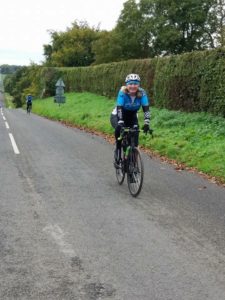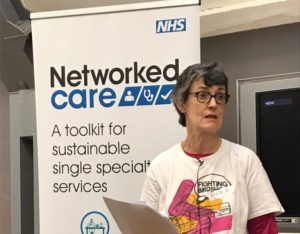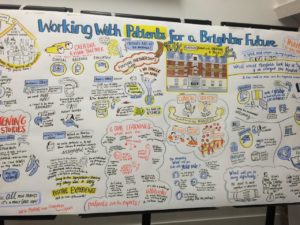
Birmingham “Patient Voice workshop” 12th July 2017
Until recently, it was unusual for doctors, researchers and patients to meet. Patients were excluded from medical conferences, other than being occasionally invited to attend as teaching subjects. Thankfully, this is changing. A meeting held at the Centre for Professional Development in the University of Birmingham Medical School (UK) on July 12th 2017 brought together patients and professionals on equal terms to exchange information and views on some of the ways patients and patient groups such as BUS are influencing ophthalmology research. Speakers included our director Annie Folkard and our research nurse Sue Southworth. The workshop was masterminded by Birmingham’s Professor Alastair Denniston.
Annie Folkard opened the workshop by describing her journey as a patient, the pathway which led to the formation of the Birdshot Uveitis Society, and the progress that has been made to date. “The Birdshot Uveitis Society is like a huge communication hub, connecting not only patients, but clinicians and researchers as well…It’s very much a partnership between clinicians, scientists, researchers, charities and people with birdshot. We all play a part in this journey together.”
Sue Southworth, senior birdshot research nurse at Birmingham, sponsored by BUS, added: “Working with patient groups puts any clinician in a privileged position. Patients’ knowledge about their experience is valuable, important and a necessary component of discussions about eye research. Clinicians don’t learn solely from textbooks and lectures. The experience they have, throughout training and beyond, informs their practice. Patients’ experience of their condition is no less valuable. Clinicians are realising this. It is important to remember that the impetus for this first ‘patient voice’ day came from a clinician: things are changing.”
A speaker from another group reminded everybody that patients are not a separate species. They are fighters, often having to fight to be believed. However, discovering and then researching what patients actually experience from their conditions and treatments is not as easy as it sounds. There is often a mismatch between what patients and clinicians each feel is important in research. ‘Patient reported outcome measures’ (PROMS) constructed without patient input are an example of this inequality. One clinician speaker had worked with patients to develop ‘patient-generated outcome and experience measures’ (POEMS) to use in his research, to capture what mattered most to patients. Also, writing good patient information is notoriously hard to do, and this is another area where patient input can help improve matters.
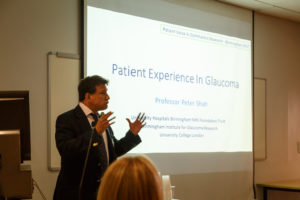
Professor Peter Shah in action
Delegates heard some interesting examples of how patients had influenced research. These included the development of a patient-held ‘glaucoma passport’ to hold their essential information; an electronic way for patients to record health events between clinic visits, and the development of an ‘artificial intelligence’ application which will eventually interpret optical coherence tomography (OCT) scans, enabling new patients in the community to have quicker access to treatment.

Pearse Keane talking about the importance of communicating and the use of artificial intelligence in interpreting scans
Good communication, with the patient centrally placed, received repeated emphasis during the day. Basic principles included the clinician adjusting their approach to each patient by getting to know them; judging their feelings and reacting appropriately; being authentic and sincere, and the importance of what is said and how it is said.
During the day, sets of some quite pointed questions were presented to delegates for them to vote on electronically. One question was whether or not the current UK requirement of having to include details of patient involvement on research grant application forms was just a trendy ‘buzz word’ requirement to obtain research funding, or whether it was a genuine move to get patients involved right from the beginning of planning research, to incorporate their views as part of the research design and ensure the project would be truly relevant to patients.
The day provided a great opportunity to meet and learn from other patient groups and those with whom they work. Groups can often feel isolated in promoting the patient voice to doctors and researchers on what really matters to patients, and in trying to get that input transformed into useful research. BUS’s presence and contributions to the meeting showed we are recognised as an important part of the ophthalmology patient group movement.
Professor Alastair Denniston, meeting co-chair, said: “BUS is a brilliant example of how patients can work together to change the status quo – and bring a new culture of research to improve patient care. At a personal level, I know that my own priorities have changed as I have learnt to listen to ‘the patient voice’ – hearing what matters to people who actually live with the condition. The ‘Patient Voice Day’ was an exciting opportunity to share our experiences in the ophthalmic community and to learn from each other across a range of conditions and backgrounds.”
For more information, follow the link to: The patient is speaking, an in-depth article published in the British Journal of Ophthalmology in March 2017.

Margaret Gilmour discussing the posters over coffee with one of the delegates
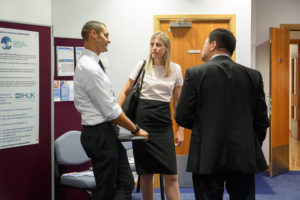
Left to right: speakers, Derek Kyte, Professor Mel Calvert from CPROR and Professor Graham Lee from Brisbane

Tessa Richards, BMJ Senior Editor Patient Partnership (left) with Geraldine Hoad from Macular Society and Tasanee Braithewaite from Moorfields Eye Hospital
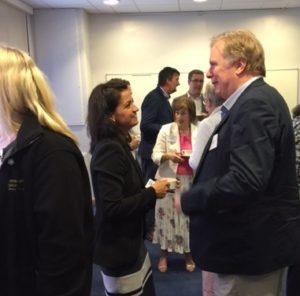
During the coffee break
Photo credits: Xiaoxuan Liu
Margaret Gilmour
July 16th 2017
